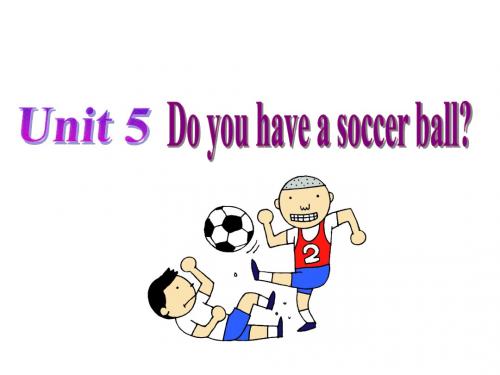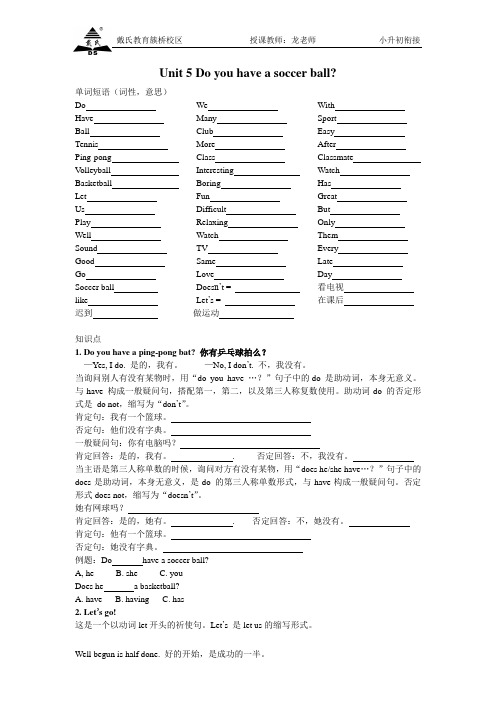2017年秋人教新目标版七年级英语上册Unit5DoyouhaveasoccerballPeriod4教案
- 格式:doc
- 大小:120.00 KB
- 文档页数:6





新目标人教版七年级英语上册Unit5 Do you have a soccerball?第一课时SectionA(1a-2c)教学设计金安苑学校刘团业一、关于教材1.单元分析:本单元的教学主要内容是:学习have 的一般现在时的疑问式的肯定和否定回答,该话题与学生的日常生活紧密联系在一起,容易唤起学生的学习兴趣,这对于提高学生的综合能力很有帮助,特别是说的能力。
本单元仍在继续学习一般现在时,这是一个生活中离不开的时态,也是最基本的一个时态。
新课程标准要求学生重点掌握一般现在时,这在英语中使用频率很高,学好这一时态的用法对以后其他时态的学习和交际有很大的帮助。
但与前几个单元be 动词的一般现在时不同,本单元开始了实义动词一般现在时的一般疑问句及其答语的教学。
2.课时分析:本单元的第一课时,是一堂听说课。
以球类物品为载体学习使用Do you have ...?/Does he/she have ...?让学生掌握实意动词的一般疑问句及其答语。
在教学设计中我以“第一课时的听说教学为第二课时的语法教学打好基础,但该在语法课讲的内容绝不挤占听说时间”为出发点,对本课的句型进行了拓展:I (don’t)have...;He/She (doesn’t have)has...但仅仅是通过大量和反复地操练是使学生运用自如,而不急于提醒has和have的使用场合。
既为后面的学习做好铺垫又留有余地。
二、学生分析学生现有的能力与已掌握的知识:学生在已经学过词汇:What is this ?What is that?句型:Where is… It’s in / on / under/…经过前面的学习学生已经积累了一定的词汇,掌握了一定的目标语,已经具备了一定的听说读写能力。
三、教学目标1.语言知识词汇:A.重点掌握表示有关各种运动球类的名词重点句型:---Do you have a ... ?---Yes,I do./No,I don’t.---Does he/she have a soccer ball ?---Yes,he/she does./No,he/she doesn’t.2.语言技能:能通过图片及实物使用目标句型进行交际。

Unit 5 Do you have a soccer ball? 单词短语(词性,意思)DoHave Ball Tennis Ping-pong Volleyball Basketball LetUsPlayWell Sound GoodGo WeManyClubMoreClassInterestingBoringFunDifficultRelaxingWatchTVSameLoveWithSportEasyAfterClassmateWatchHasGreatButOnlyThemEveryLateDaySoccer ball like Does n’t =Let’s =看电视在课后迟到做运动知识点1. Do you have a ping-pong bat? 你有乒乓球拍么?—Yes, I do. 是的,我有。
—No, I don’t. 不,我没有。
当询问别人有没有某物时,用“do you have …?”句子中的do 是助动词,本身无意义。
与have 构成一般疑问句,搭配第一,第二,以及第三人称复数使用。
助动词do 的否定形式是do not,缩写为“don’t”。
肯定句:我有一个篮球。
否定句:他们没有字典。
一般疑问句:你有电脑吗?肯定回答:是的,我有。
. 否定回答:不,我没有。
当主语是第三人称单数的时候,询问对方有没有某物,用“does he/she have…?”句子中的does是助动词,本身无意义,是do 的第三人称单数形式,与have构成一般疑问句。
否定形式does not,缩写为“doesn’t”。
她有网球吗?肯定回答:是的,她有。
. 否定回答:不,她没有。
肯定句:他有一个篮球。
否定句:她没有字典。
例题:Do have a soccer ball?A, he B. she C. youDoes he a basketball?A. haveB. havingC. has2. Let’s go!这是一个以动词let开头的祈使句。
Self Check教学内容Self Check(教材P30)教学目标知识与能力过程与方法运用Summarizing和Classifying的学习策略。
在复习教学中,运用听写、提问、对话演练与检测,促使学生不断地使用所学内容,从而提高他们灵活运用知识的能力。
教学重、难点及教学突破重点复习词汇tennis,racket,bat,volleyball,basketball,television,interesting,boring,fun,difficult,relaxing教学突破通过各种复习手段的检测,促使学生掌握所学知识,并能使用所学知识进行交际活动。
教学准备教师准备制作能显示本单元重点词汇和句型的单词图片;设计课后巩固练习的幻灯片。
学生准备复习所学词汇、句型和语法内容,并进行适当的总结、归类。
教学步骤(1课时)一、第一教学环节:情景创设。
导入新课教师活动学生活动引导学生进行关键词自我检测,完成自我评估,复习所学的重点词汇,完成第1部分的教学内容。
进行关键词自我检测,完成自我评估,复习所学的重点词汇,完成第1部分的学习要求。
二、第二教学环节:师生互动。
学习探究教师活动学生活动2.引导学生根据图画内容整理对话的顺序,并复习所学的目标语言,完成第3部分的教学内容,复习、巩固所学的Do you have…?Yes ,I do .No ,I don’t.等句型和语法知识。
2.根据图画内容整理对话的顺序,并复习所学的目标语言,完成第3部分的学习要求,复习、巩固所学的Do you have…?Yes,I do .N0,I don’t.等句型和语法知识。
本课总结通过单词检测、对话练习和游戏等,对所学知识讲行系统而全面的复习和巩固,不仅使学生掌握所学知识,更重要的是培养灵活运用的能力;同时教授学生了解一些有效的学习策略。
板书设计Unit 5 Do you have a soccer ball?Self CheckWords: tennis, racket, bat, volleyball, basketball, television, interesting, boring, fun, difficult,relaxingSentences: Do you have …? Yes, I do. No, I don’t. Let’s play …. That sounds …问题探究与拓展活动every day与everyday:every day为名词短语,作时间状语,意思是“每天;天天”;everyday是形容词,意思是“每天的;日常的”。
《 Unit5 Do you have a soccer ball》教案备课时间:2017 10 27课题Unit5 Do you have a soccer ball?Section B 1a-1d授课时间2017 10 31教学目标知识与技能1学习描述性的形容词interesting, fun, relaxing, boring, difficult2 学生听力能力的培养和锻炼。
3两个重点句型:Let’s……以及That sounds……过程与方法通过同学间一起参加体育活动,学习正确使用描述性的形容词情感、态度、价值观1、激发学生学习英语的兴趣,发挥学生学习英语的主动性。
2、通过小组活动、小组竞赛,培养学生的合作意识和团队精神。
3 引导学生热爱生活,了解体育锻炼与身体健康的关系,注重自己的体育锻炼,加强身体健康。
教学重点学习描述性的形容词interesting, fun, relaxing, boring, difficult教学难点两个重点句型:Let’s……以及That sounds……教学方法我运用课本和多媒体,采用小组竞猜的方法,激发他们的学习兴趣和斗志教具课本多媒体教学过程Step1 Revision通过PPT展示图片,生动形象,教师教授生词,学生便于记忆。
Step2 Presentation1 教师播放PPT,并配上丰富的表情,和学生一边观察一边描述:It’s interesting/ boring/fun/ difficult/relaxing.让学生反复跟读,并通过教师的表情或者图片内容理解单词的意思。
2 对于较长的单词,注意渗透语音教学,教学生有意识的地按音节去记忆和拼写单词,以降低学习的难度。
3 让学生将描述性的形容词与图片一一对应,完成1a活动任务。
4学生听力能力的培养,播放录音,要求学生一边听录音,一边勾出听到的单词,完成1b。
5 再次播放录音,让学生看1c的练习要求,先理解题目和各组短语的意思。
人教版新目标版七年级英语上册Unit5Doyouhaveasoccerball教案Unit 5 Do you have a soccer ball1.知识与能力目标:1).能预习并说出这单元的主要内容。
2).能运用目标语言询问并描述物品所属关系。
.2.过程与方法目标:通过运用本单元的目标语言,反复练习句型“Do you have a soccer ball? ”“Yes,I do.”“No,I don’t.”从而掌握本单元的重点句型和词组。
3.情感态度与价值观:本单元通过运用过去完成时态,让同学们学会与朋友共度快乐的时光。
Section A第一课时一、课型:新课二、教学重难点:1).Do引导的一般疑问句及其回答。
2)do 和have的意义及用法3)学习有关物品的新单词:tennis、ping-p ong、soccer ball 、volley ball、basketball、baseball、bat。
三、教学准备:多媒体,录音机四.教学过程:1.课前预习回顾上单元所学内容,引出本单元新句型:T:Where’s my book?S: It’s on your desk.T: Where are my pens?S:They’re in your box.T: Yes,thank you! I have a pen,do yo u have a pen?S:Yes,I do./No,I don’t.2.正课教授(1)引入①观察25页图片,引入新单词的学习。
②学习do引导的一般疑问句及其肯定回答和否定回答。
have的用法:①have为实义动词,意为“有”,常用句型sb.have/has+sth.表示某人有某物。
当主语为第三人称单数时,have用其第三人称单数形式。
②have还有“吃、喝”的意思,如:have breakfast。
③含有have的句子变否定句要在have前加don’t;含有has的句子变否定句要在h as前加doesn’t,has变为have。
Unit 5 Do you have a soccer ball?Period 4 (Section B 2a–Self Check)【教学目标】●知识目标1. Master the new words and useful expressions.2. Master the target language.●能力目标1. Be able to grasp the main idea of the article.2. Be able to express one’s feelings.3. Develop students’ writing competence.●情感目标Educate students to express their own feelings.【教学重难点】●重点1. Master the new words and useful expressions.Words: student, sport, to, same, love, with, them, only, like, easy, after, class, classmate Expression: play sports2. Be able to grasp the main idea of the article.3. Be able to express one’s feelings.●难点Consolidate the use of have/has.【教学准备】The text book and handouts.【教学方法】任务型教学法、情景交际法、自主学习与合作学习相结合【课时安排】One period【教学过程】Step 1: Greetings and revision1. GreetingsT: Good morning, everyone.Ss: Good morning, teacher. How are you?T: Fine, thanks. And you?Ss: I’m OK.2. RevisionReview what we learned in the last period.Step 2: Lead-inT: We have finished most of Unit 5. And in this period, we will continue to finish Section B. But before that, I would like you to review what we learned before.Step 3: Presentation1. Teach activity 2a(1) T: First, read through the instruction of this activity so that you can know how to do this activity.(2) Then find the sports words in this unit. Write them in the correct columns. Ask them to do it individually.(3) Leave the students three minutes to do this activity, and check the answers later.2. Teach activity 2b(1) T: Now. Read through the instruction so that you can know how to do this activity.(2) Read the passage and answer the question: Who has a soccer ball?T: Let’s move to the activity 2b. Would you please look read the passage and answer the two questions?(3) Check the answers.T: I think most of you have finished. Please read the passage with your partners and check your answers together.Answers: Alan has a soccer ball.Gina Smith has two soccer balls.(4) Read. First, ask the students to read the passage together. Then, invite some of them to read it for the class.3. Teach activity 2c(1) Ask students to read through the instruction of this activity so that they can know how to do it.(2) Leave students two minutes to do this task individually. Move around the classroom to check the progress and give some help if necessary.(3) Invite some pairs to check their answers.Answers:Step 4: Practice1. Teach activities 3a(1) T: Let’s work on 3a. First, have a quick look at the instruction and the chart in 3a so that you can know how to do this activity.(2) Ask students to write more questions about sports equipment.T: Review the words and phrases from the unit. Then write some more questions about sports equipment for the survey.(3) Leave students several minutes to do it.2. Teach activity 3b(1) Exchange books with a partner. Answer his or her questions in 3a.T: Do you have any other words you don’t know? Please write them in your n otebook. Please ask your friends for help. Looking up words in a dictionary is also a good way to study English.I hope you can get more from dictionaries. Please exchange books with a partner and do the survey.(2) Leave students several minutes to do this task.(3) As they work, move around the room, checking progress and offering help as needed.3. Teach activity 3c(1) T: Go over the sports survey you did in 3a. How many sports do you have? And how many sports does your partner have?(2) Ask the students to write them down like the sample sentences.(3) Leave the students several minutes to do it. Collect the answers later.(4) Check mistakes if there is any.Step 5: ConsolidationTeach Self Check1. Self Check 1(1) T: We’ve learned many words about sports. Can you speak out?(2) Invite some students to list them on the blackboard. Ask and answer like this:T: Do you have a volleyball?S: Yes, I do./ No, I don’t.T: Can you play it?S: Yes, I can. It’s fun./ Sorry, I can’t. It’s difficult for me....(3) Ask students to talk about them in pairs like this.2. Self Check 2(1)T: First, have a quick look at the instruction and conversations so that you can know how to do this activity.(2) Ask students to do it individually or in pairs.(3) Check the answers.Answers: 1.Does your mom have a baseball bat?2.Yes, I do./ No, I don’t.3.Does your father have a soccer ball?4.Does your teacher have a soccer ball/ basketball/ volleyball/ baseball?(4) Ask students to read the complete conversation together.(5) Pay attention to the pronunciation and intonation.【课堂小结】In this period, we’ve learned how to make survey reports through some reading and writing practice. And we’ve also consolidated the grammar we have learned in this unit through some activities.【课后作业】1. Review the new words and useful expressions in this period.2. Read the messages again and again in 2b.3. Finish the exercises on the workbook.4. Preview the next unit.。